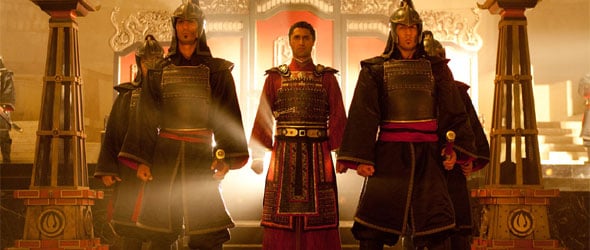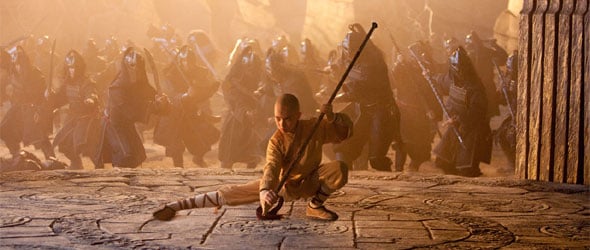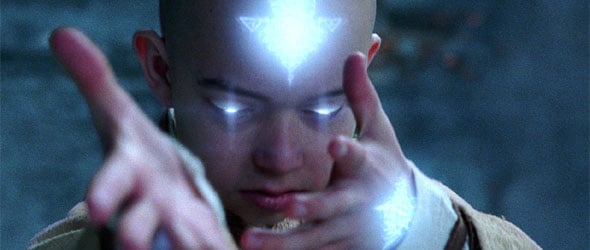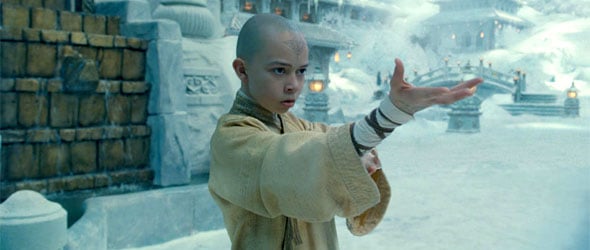To 3D Or Not To 3D: Buy The Right Last Airbender Ticket

Your biggest decision at the movie theater right now isn't what to see, but how to see it. The Last Airbender opens in 3D this weekend and it's just the latest in a long, endless line of 3D Hollywood releases. If you've read my review you know that I'm one of the few people who liked it, but this won't be a discussion of Airbender's merits as a film.
Instead my goal here is to give you some sort of guideline to help decide how to see it, should you choose to. 3D tickets are more expensive than 2D tickets yet, 3D isn't even the best way to see some movies. To help you navigate the increasingly confusing 3D waters, we've developed a mostly unbiased, 7-point system for determining whether 3D is the right choice for you. In order for this analysis to work, for better or worse I'll ignore the quality of the film as a whole and instead give an assessment of the movie's 3D on a mostly technical level. Using that, you'll have the tools you need to buy the right Last Airbender ticket in the right format, and at the right price. Read on.

Is 3D A Fit?
The Last Airbender is a live action movie and, to date, 3D has only really worked well on computer animated films. Hollywood has yet to prove the 3D belongs in live action movies and M. Night Shyamalan isn't going to be the one to prove it. It is, however, based on an anime series which used a lot of bright colors, and that could help compensate for some of the problems of converting live action into the third dimension. It's also pretty effects heavy and full of massively scaled set pieces. Watching characters manipulate the elements in the third dimension could, I suppose, be kind of cool. Until someone figures out a way to make 3D work with live action though, this was probably a bad idea.
3D Fit Score: 2/5

Advance Planning And Effort
This is one of those last minute, cash-in, 3D conversions of the type used on Clash of the Titans. What that means is that unlike the best 3D films, such as Avatar, the movie wasn't originally created to be in 3D and in fact it wasn't even shot with 3D in mind. Instead, the studio suits behind it saw how much money the 3D movies are making and hastily converted it to the format at the last minute, plastering 3D on the posters and jacking up ticket prices accordingly. The movie's director M. Night Shyamalan was reportedly involved in the conversion, but I'm not sure how much that matters since the movie was already done in 2D by the time they got around to turning it into a 3D film. It seems clear that not a lot of thought, beyond how much money they could make, actually went into this.
Planning And Effort Score: 1/5

Picture Depth
Your Daily Blend of Entertainment News
The reason most often given for converting movies into 3D is depth. Used properly 3D can give the picture in front of you the illusion of extra depth and make it feel as though you're watching something happening through a window, rather than flat images projected on a screen. The Last Airbender's 3D conversion does indeed give the movie depth, unfortunately it's the wrong kind. The images you'll see on screen look like a series of paper cutouts inside a shadow box, rather than real images happening just a few feet away. The movie's images are so colorful and high contrast that the film's hasty 3D conversion is incapable of really fitting them all into the environment. If this were an animated movie, maybe we wouldn't notice, but since it's live action you will. The Last Airbender's 3D has depth, but it's the wrong kind of depth.
Picture Depth Score: 1/5

Brightness
One of the biggest problems with 3D is the haze created by those filtered glasses you're forced to wear. The best way to compensate for this is by only using 3D on brightly colored, high-contrast movies. The Last Airbender is just such a movie. During daylight scenes the colors are stunningly vibrant, the visuals sharply defined. Each and every moment of the film is perfectly framed and sharply directed. Even in scenes which take place at night, the color contrast is extremely sharp, and the lighting levels on screen are never low enough that you'll have any problem watching it through the unavoidable 3D haze created by watching anything in 3D. How well this plays out on screen when you see it may or may not be impacted by the way it's projected in your theater. Some believe theater owners should increase the brightness on their projectors to combat the dark filters on your glasses lenses, and not every theater owner actually goes through the trouble to do this. But that's out of the control of The Last Airbender's makers who have, at least, created a movie that's bright enough and sharply defined enough to potentially work in the 3D format.
Brightness Score: 5/5

Flair
3D can be gimmicky, with characters thrusting things towards the camera in an effort to scare the audience. But those same gimmicks can also be used to add extra value to the 3D experience. As long as you're using the technology, why not use all the tools it affords you? Filmmakers who only use 3D to provide depth are only using half of its power. Avatar used it to full effect frequently, as in the scene where seed pods appeared to float down over the audiences head. Other movies, like Alice in Wonderland took a more gimmicky approach. In both cases though, whether it was entirely successful or not, at least they were trying. The Last Avatar doesn't even try. Since it's the product of a last-minute 3D conversion Airbender contains none of those little extras. 3D is used on The Last Airbender only to provide depth, and it does that poorly.
Flair Score: 1/5

Audience Health
This is a somewhat subjective criteria since 3D affects different people differently. Many people have reported persistent headaches with all forms of 3D, some simply can't see in 3D at all. Take all of that into consideration before seeing any 3D movie. For my part, I can report no undo dizziness, headache, or fatigue caused by The Last Airbender, nor did anyone I spoke to afterward report any of the most common 3D caused symptoms. This may be, in part, because of how bright the movie is. Dimly lit 3D movies are the most likely to cause illness, headaches, or fatigue since your eyes are forced to strain in order to see the movie. That won't be a problem with Airbender.
Health Score: 5/5

The Glasses Off Test
If you've ever taken your glasses of while watching a good 3D movie, you probably noticed that during the most 3D intensive parts of the film, the picture on screen became even fuzzier. The simplest way to explain this is to say that the blurrier the image on screen appears when seen without glasses, the deeper and more vibrant the 3D is likely to be with your glasses on. So to test this, I removed my glasses periodically during The Last Airbender to examine the way the movie's 3D effects were being created. In close-ups or scenes without action, there was almost no visible difference between watching the movie with my glasses on or my glasses off, other than that the movie seemed more bright without the lens filters. In action scenes or wide shots though, the movie became utterly unwatchable without my glasses, a sign that Airbender was at least attempting to use 3D to its maximum potential.
Glasses Off Test: 3/5
| SCORES RECAP | |
| 3D Fit | 2 |
| Planning and Effort | 1 |
| Picture Depth | 1 |
| Brightness | 5 |
| Flair | 1 |
| Audience Health | 5 |
| The Glasses Test | 3 |
| Total Score | 18 (out of a possible 35) |
Final Verdict: I'm still not convinced that live action movies should ever be in 3D, but if someone's going to make it work they'll have to put more effort into it than The Last Airbender did. This is a hasty, last-minute 3D conversion, a cynical cash-grab. Don't fall for it. If you see it, make sure you buy a 2D ticket.
For more 3D analysis, visit our To 3D Or Not To 3D archive right here.

